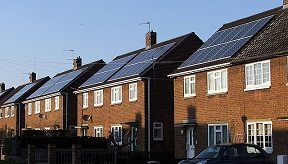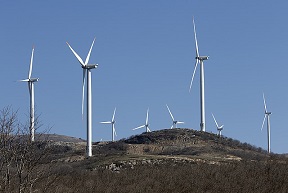The sun doesn’t always shine. Sometimes there is not a breath of wind, sometimes it storms. As we move forward towards sustainable sources in the energy transition, we need to balance better supply and demand. Data are a prerequisite for this service: the digitisation of electricity supply.

New challenges
It is more difficult to control a sustainable energy system than a fossil system. The amount of solar and wind energies depends on weather conditions. And there is an increasing number of parties, both companies and citizens, that will produce and trade electricity. Whereas electricity demand keeps on growing, for instance through cooking or driving electrically, economic growth and digitisation in many sectors of the economy. Both supply and demand will be much more variable. We start running into limits already. In some locations, solar panels cannot have a grid connection, because of the threat of overcharging the net. We need digital innovations (link in Dutch).
Rathenau Institute, a Dutch institute for research and dialogue relating to the societal aspects of science, innovation and technology, investigated this it its report Stroom van data (2022) (link in Dutch). How can citizens, businesses and high-voltage companies prepare for a more sustainable, flexible and decentralized energy system? This will require adaptive strategies from all stakeholders – adaptation that will primarily take the form of automatic responses. In case of oversupply of energy, it needs to be stored, for instance in the batteries of electric cars. In case of undersupply, energy needs to be discharged again for public use. We call an aggregator the party that takes care of these adaptations.
The aggregator
Companies and households can make use of the services of an aggregator through a subscription; this will lend to the aggregator the power to have a look ‘behind the meter’ in order to establish any regularities in electricity use. Including data of solar panels, household appliances and a domestic battery. On the basis of these data, the aggregator will develop predictions on supply and demand. Predictions that will be more reliable as the number of data and of parties involved, will be larger.
This will open up major vistas on better control of the grid – urgently needed in order to prevent the system from meeting its boundaries. But in order to reach this point, Rathenau says, we need to have data that are accessible and interoperable – applicable in the entire electricity system. This will require devices to be connected to the internet; and to be fitted with an interface with which they can communicate, and be turned on and off.

Abuse
And yet, so Rathenau continues, this will open up opportunities for abuse of data – that may give rise to new, hard to control power positions in the system. We need to prevent this, and therefore create a legal system; with a uniform system of protocols over a large grid, for instance in Europe. This should prevent abuse by malevolent parties. And we need supervision, in this system too! On the one hand, companies need to see opportunities in easing the burden of their customers; on the other hand, we need to prevent winner-takes-all-situations. Moreover, these companies need to be able to defend themselves against cyber-attacks; but not win a decisive advantage over digitally less endowed customers.
We also need data management in order to prevent infrastructure overload – maybe causing blackouts. Therefore, grid companies should actively control their grids. By making better predictions, both on the demand side through predictive loadflow analyses, and on the supply side by making adequate weather predictions. In order to balance supply and demand, they need to develop new pricing systems. For instance, these should incentivise consumers to balance in-house as much as possible any excesses in supply and demand. Although we should prevent price systems to stand in the way of the energy transition as such.
The promise of crowd balancing
A possible solution to this problem is the buildup of small-scale and decentralized flexibility services. Based on batteries, heat pumps or electric cars. These devices can postpone their electricity demand (or supply) to appropriate moments. This is called crowd balancing. This can only be facilitated if individual consumers can reliably and controllably use and supply electricity, as needs be. Digital technology and trustworthy data are a prerequisite to this end.
Aggregators can facilitate this process. Grid owners can predict shortages at short notice, say fifteen minutes. They will issue a call on parties to supply the amount required, and choose the cheapest supplier. A purely automatic process. If an aggregator wins such a bidding, it uses its own Internet-of-Things-platform (like electric cars or household batteries) for supply of the service required. In case of an excess, the opposite will happen.
A level playing field
The consequence of this system is that the electricity market would become a level playing field. Anyone can have access to the energy market and make a profit in it – not just a select group of actors. Of course, on the condition that the party involved can command a sufficient number of appliances – household batteries, solar panels, heat pumps, electric vehicles – that can deliver flexibility and can be integrated into aggregator systems. And on the condition that the standards are open, not just determined by one or two powerful players; as happened earlier with mobile phones’ operating systems.
In such a system, local optimization may relieve pressure on high-voltage grids. The Dutch village of Heerten hosted an experiment to that end between 2017 and 2020. The experiment’s goal was to use as much as possible within the neighbourhood the locally generated electricity. For instance, batteries stored solar power in daytime and used it at night. Therefore, all participants had access to an energy management system, coupled to a smart meter. The participants received real time data on energy use and – if applicable – also on generation by solar panels and storage by batteries. The system resulted in lowering total peak demand by 25% to 35%. Mainly through the automatic local battery management.
Digitisation and local communities
The energy transition goes on at high speed. People increasingly buy solar panels, batteries and heat pumps, on their own or in a community. In the latter form they share data, using digitisation. This lends them more power over the use of the locally sourced energy. Therefore, such an energy community will contribute to local support for the energy transition. Moreover, participants will tune their supply and demand to each other, alleviating the pressure on high-voltage companies.
Moreover, such a community will be able to act externally as a community Virtual PowerPlant (cVPP). Making use of the same mechanism, they will also exert a stabilizing effect on a higher level. This will continue to increase in prominence. At the moment, at least in the Netherlands, the feed-in tariff into the grid equals the delivery tariff – as if distribution costs do not count. But around 2028 this arrangement will stop, and then it will become much more attractive to use one’s energy oneself, or within a community.
Digitisation and communication
For such a system to work properly, a standard communication protocol is a must. Europe urgently needs to develop such a standard protocol. Which will allow the community to control equipment connected to it. In order to establish that, we need to develop open source software soon – again to prevent market parties to develop a dominant position. Therefore, the European Commission’s Clean Energy Package needs to be used as soon as possible. At the moment, this still awaits consent in the Netherlands, because the Energy Law hasn’t been approved yet. For the further development of energy communities, this package is of major importance.
Therefore, digitisation is indispensable in reaching the goals of the energy transition. It will allow us to balance supply and demand, whereas the energy system itself will become more flexible. But the possible development of new power positions poses a challenge that needs to be met. It could for instance lead to an unjust distribution of charges and benefits. Moreover, the knowledge of the breakdown of a customer’s use pattern will become ever more important – the so-called data behind the meter. So far, the customer’s legal position with regards to the use of these data hasn’t been well protected. We should prevent internet companies to use their power position in misuse of these data.
Fast developments
In regulating this field, technological development will be of major importance. Like new cooling technologies, energy storage, decentralized data management and all sorts of use of AI. Energy conservation will become more important as well. And have we thought adequately already about the spatial consequences of data centres?
Developments are fast. We need to discuss more the interweaving of digitisation and energy transition. So far, energy policy has been determined to a large extent by values like ‘reliability’, ‘cost effectiveness’, ‘safety’, ‘low environmental impact’ and ‘spatial responsibility’, says Rathenau Institute. With digitisation in sight, new issues arrive on the horizon. Issues like privacy, safety, fairness, autonomy and the equitable distribution of power. Will the energy transition live up to these values?
Interesting? Then also read:
Local optimization, against congestion on the grid
The energy transition is a digital transition too
Energy storage will accelerate the transition
